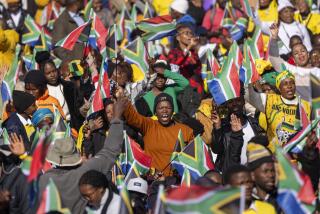COLUMN LEFT : Mandela’s Way: The Road Not Taken : Cold War politics put U.S. and South African blacks on divergent paths.
- Share via
Nelson Mandela is about to visit Los Angeles and the national NAACP leadership will meet here next week. These twin events put into focus the relationship between blacks in South Africa and in the United States. The differences in how these two communities have responded to racism extend far beyond the fact that one is an oppressed majority and the other is a discrete minority.
Ironically, the Cold War was a significant factor in eroding Jim Crow in the United States and in encouraging the onset of apartheid in South Africa. How could Washington continue howling about human-rights violations in the Soviet Union when most African Americans could not vote or eat at certain lunch counters or be buried in some cemeteries? Simultaneously, Washington’s search for allies in this global struggle allowed the ruling party in Pretoria to promulgate apartheid in 1948, proclaiming the African National Congress a veritable tool of Moscow. Then as now, the ANC was allied with the South African Communist Party and Washington lent a sympathetic ear to the government.
The NAACP had not been indifferent to the U.S. Communist Party in the pre-Cold War era. Many of its leaders, especially Roy Wilkins, lent support to the black Communist lawyer Ben Davis when he was elected to the New York City Council from Harlem in 1943 and 1945. But unlike the ANC, the NAACP broke these ties in the postwar period; hence, founder W.E.B. Du Bois was ousted in 1948, the group supported wars in Korea and Vietnam and barred Communists from membership as part of a de facto Faustian bargain that led to concessions on civil rights. The ANC chose not to take this path.
The consequences of the NAACP’s choice resonate to this day. With the left still marginalized among blacks (not to mention the nation as a whole), black youth in particular face unpalatable choices. One is a pallid integrationism that has the virtue of organizing across racial lines. But the absence of militance provides little appeal for youth, who recognize that militance has historically been the engine bringing gains to our community. The other is a narrow nationalism, symbolized by the throngs greeting the Rev. Louis Farrakhan, that is verbally militant but is self-defeating in its lack of organization, a historical approach and chauvinism. Eastern Europe is now discovering the lesson learned ruefully by blacks, that decline of the left leads to the rise of narrow nationalism.
Though racism in South Africa is more severe than it is here, Farrakhan’s sexism and anti-white rhetoric would be viewed with far greater skepticism in Soweto. Similarly, the NAACP’s anti-communism would receive outraged disbelief.
When Mandela was freed, he singled out for special praise the Communist Party and its leader, Joe Slovo, who is of Lithuanian-Jewish descent and who has quite a following in black South Africa. Meanwhile, U.S. youth are captivated by rap groups like Public Enemy, which engage in anti-Semitic allusions.
When the left was marginalized in the United States, along with it went the idea that racism stemmed from profit and the operations of a system. It became inevitable that blacks, seeking new explanations for their plight, would blame Euro-Americans as a whole.
The ANC speaks explicitly of redistribution of wealth; despite the significant disparities of wealth that also exist in the United States, this demand is curiously absent from the agendas of most civil rights organizations. Indeed, the NAACP was reluctant to take up the cause of the anti-apartheid movement because of its allergy to the left, and relented only recently.
It would be simpleminded to blame just the NAACP for this sad state of affairs. Powerful elites backed its leaders into this corner. But Nelson Mandela and the ANC also faced powerful enemies and decided to stare them down; now they are on the verge of taking over a government and a sizeable state-owned economy with the aim of improving the well-being of the black majority. Meanwhile, African Americans face an uncertain future as the scientific and technological revolution has undermined a major base of livelihood--factory jobs--while our crumbling system of education is not preparing blacks for an increasingly gloomy tomorrow.
Nelson Mandela represents the road not taken, though it is still not too late for the NAACP and other civil rights organizations to learn from his example.
More to Read
Sign up for Essential California
The most important California stories and recommendations in your inbox every morning.
You may occasionally receive promotional content from the Los Angeles Times.













